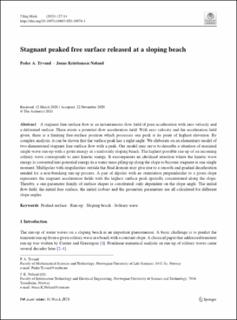| dc.contributor.author | Tyvand, Peder A. | |
| dc.contributor.author | Nøland, Jonas Kristiansen | |
| dc.date.accessioned | 2021-03-16T09:57:22Z | |
| dc.date.available | 2021-03-16T09:57:22Z | |
| dc.date.created | 2021-03-13T11:07:40Z | |
| dc.date.issued | 2021 | |
| dc.identifier.citation | Journal of Engineering Mathematics. 2021, 127 (14), . | en_US |
| dc.identifier.issn | 0022-0833 | |
| dc.identifier.uri | https://hdl.handle.net/11250/2733570 | |
| dc.description.abstract | A stagnant free-surface flow is an instantaneous flow field of pure acceleration with zero velocity and a deformed surface. There exists a potential-flow acceleration field. With zero velocity and the acceleration field given, there is a limiting free-surface position which possesses one peak at its point of highest elevation. By complex analysis, it can be shown that the surface peak has a right angle. We elaborate on an elementary model of two-dimensional stagnant free-surface flow with a peak. Our model may serve to describe a situation of maximal single-wave run-up with a given energy at a uniformly sloping beach. The highest possible run-up of an incoming solitary wave corresponds to zero kinetic energy. It encompasses an idealized situation where the kinetic wave energy is converted into potential energy in a water mass piling up along the slope to become stagnant at one single moment. Multipoles with singularities outside the fluid domain may give rise to a smooth and gradual deceleration needed for a non-breaking run-up process. A pair of dipoles with an orientation perpendicular to a given slope represents the stagnant acceleration fields with the highest surface peak spatially concentrated along the slope. Thereby, a one-parameter family of surface shapes is constituted, only dependent on the slope angle. The initial flow field, the initial free surface, the initial isobars and the geometric parameters are all calculated for different slope angles. | en_US |
| dc.language.iso | eng | en_US |
| dc.publisher | Springer | en_US |
| dc.relation.uri | https://link.springer.com/article/10.1007%2Fs10665-020-10074-3 | |
| dc.rights | Navngivelse 4.0 Internasjonal | * |
| dc.rights.uri | http://creativecommons.org/licenses/by/4.0/deed.no | * |
| dc.title | Stagnant peaked free surface released at a sloping beach | en_US |
| dc.type | Peer reviewed | en_US |
| dc.type | Journal article | en_US |
| dc.description.version | publishedVersion | en_US |
| dc.source.pagenumber | 19 | en_US |
| dc.source.volume | 127 | en_US |
| dc.source.journal | Journal of Engineering Mathematics | en_US |
| dc.source.issue | 14 | en_US |
| dc.identifier.doi | 10.1007/s10665-020-10074-3 | |
| dc.identifier.cristin | 1897818 | |
| dc.description.localcode | This article is licensed under a Creative Commons Attribution 4.0 International License, which permits use, sharing, adaptation, distribution and reproduction in any medium or format, as long as you give appropriate credit to the original author(s) and the source, provide a link to the Creative Commons licence, and indicate if changes were made. The images or other third party material in this article are included in the article’s Creative Commons licence, unless indicated otherwise in a credit line to the material. If material is not included in the article’s Creative Commons licence and your intended use is not permitted by statutory regulation or exceeds the permitted use, you will need to obtain permission directly from the copyright holder. To view a copy of this licence, visit http://creativecommons.org/licenses/by/4.0/. | en_US |
| cristin.ispublished | true | |
| cristin.fulltext | original | |
| cristin.qualitycode | 1 | |

